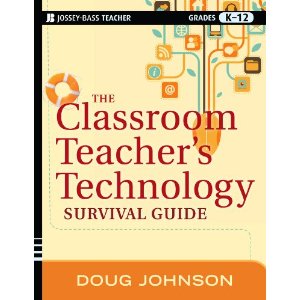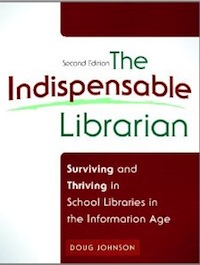Libraries in the Clouds
Libraries in the Cloud
LMC, May/June 2011
As we look to the future, every K-12 technology leader reading this article should consider the following challenges:
- Forget about IT as you know it today;
- Get ready to outsource IT;
- Let go of the desire to control;
- Embrace diversity in the IT environment;
- Blow the lid off of storage limits; and
- Quit saying things like, “A wired network infrastructure will always be necessary because wireless will never be fast enough for everything.”*
The bold predictions made above by COSN are in large part a response to K-12 schools rapidly moving to “cloud-based” networking environments. This is a radical shift on how schools provide access to resources, computer applications and file storage to staff and students alike.
And librarians need to understand the implications.
What is cloud computing and what are its advantages?
Anyone who has used GoogleDocs, a set of online productivity tools that allows the creation of documents, spreadsheets, presentations and surveys, has experienced cloud computing. (See Head of the Edge, May/June 2011)
Cloud computing relies on applications and file storage that reside on a network – usually the Internet itself - with minimal resources stored on local computers’ hard drives. (A cloud graphic is often used to represent the Internet on network diagrams, hence the name.) If you have ever stored a file online, edited a photo with an online tool, or used a web-based e-mail program, you have already experienced cloud computing.
There are many genuine advantages to cloud computing. Since both applications and one’s files reside on a network rather than on a specific computer, one can work on any project, anywhere regardless of the computer being used. Given a computer with Internet access - on one’s desk at school, on one’s lap at home, in any computer lab or coffee shop in the world, or at Grandma’s house - one can work without worrying about transporting files on physical media like flashdrives, keeping track of the latest version of a document, or having the right software to open a file. Just as importantly files are easily shared and collaboratively edited in a cloud-base application without having to resort to e-mail attachments and the confusion of multiple versions attachments can create.
Unlike much software that resides on computer hard drives, web-based applications that perform a wide-array of productivity tasks are usually provided at no cost to the user. While not as comprehensive as Microsoft Office, iLife or Adobe Photoshop, these tools often have a surprisingly full feature set and are compatible with popular commercial programs.
Cloud computing requires less powerful computers such as netbooks. A school district’s computing costs can be lowered using these inexpensive computers, free file storage and free applications. Money that would have been spent on student workstations in labs, big file servers, support staff, and expensive software can now be used to pay for increased bandwidth, greater wireless coverage or, maybe, just maybe, lower class sizes.
1:1 student to computer plans are more feasible using cloud computing. With a low cost netbook and the cloud, student computers are virtually interchangeable, so if a device needs repair or is left at home, another machine can be easily substituted. At some point, K-12 schools will ask parents to provide basic computing devices for their children as a part of the school supply list. As a parent, I was asked to purchase a $100 graphing calculator for my son when he was in high school only a few years ago. How big a stretch is it to ask parents to provide a $250 netbook computer that can be used in all classes today?
How can librarians take advantage of cloud-based computing today?
Before advocating for cloud computing for my staff and students, I decided to see if I could “live in the cloud” as a computer user – both personal and professional - myself. These are my top computer uses and how I have moved my tasks to the cloud:
- Netbook. Rather than using a full-scale laptop computer, I used a 10” ASUS laptop that cost about $300. The smaller keyboard and screen size took some getting accustomed too, but I found I could work on the computer for long periods of time. The speed is acceptable, the battery life is good and the wireless connectivity was fast.
- E-mail. Our district has move successfully transitioned to Gmail accounts for all staff and students. I have long been a Gmail user for my personal e-mail.
- Web searching and bookmarking. My delicious.com account has been a long time cloud-based tool.
- Word processing, presentation creation and spreadsheet use. After years of using Office, the move to GoogleDocs for my day-to-day productivity has been surprisingly easy. In fact, getting away from Office’s “feature creep” has been refreshing. The presentation program lacks animation, transitions, and in-program image editing. But for 95% of my work and for storing my files, GoogleDocs works just fine, thank you. The work I create is compatible with Office as well. Google adds features to its Docs suite on a regular basis. There are no skills in our information literacy/information technology curriculum that cannot be taught and practiced using GoogleApps for Education.
- Photo storage and editing. I’ve been storing my best photographs on a commercial storage site for years and editing them with Photoshop Elements. But Flickr and Picasa are online applications that work just fine for this amateur’s editing and storage needs. Picasa gives iPhoto a run for its money as a photo organizer. And Picnik allows me even more photo editing abilities.
- Web page editing and webmastering. My personal blog, wiki, and website are already completely managed via an application service providers who use online tools for management and editing. As does our school website. As do the professional association websites I help manage - Kiwanis, our lakes association, and our state library/tech association.
- School specific tasks. All gradebooks, reporting systems, and communications in our district are web-based, as are our accouting and other management systems. Period. Nearly every school document I create, share and collaboratively create is in GoogleDocs, not on my computer’s hard drive.
- Library catalog and circ system. Our Destiny circ/cat system is accessed by both library staff and library users via a webbrowser. For a nominal fee, a regional telecommunications agency hosts, maintains, and upgrades the system for us. No local storage costs or maintenance!
The future of cloud-based computing.
It’s a good time to consider the impact of cloud computing on our libraries. Now is the time to consider:
● Does your school have a policy about student owned devices that can be used to access the resources you provide in the cloud? (Parents will not allow a simple ban on them, anymore than they allowed schools to ban cell phones.)
- Does your school have the reliable, adequate and secure wireless infrastructure to support dozens, if not hundreds, of student-owned computing devices designed to take advantage of cloud-based applications?
- Is your library helping your teachers and students receive the training, resources and strategies to use the cloud?
- Is your district exploring cloud-based enterprise solutions like Google Apps Education Edition or Microsoft’s Office365?
- Is your library using cloud-based applications to lower its operating costs?
- Might libraries re-purpose those general use computer labs, providing instead a combination of lots of wireless netbooks that can be used anywhere in and out of the library and fewer, but more powerful media production computers in common labs?
But remember - every cloud can have a silver lining, especially for our library users!
The Future of Information Technology: How The Next Ten Years Will Fundamentally Change the Role of the K-12 CTO: Executive Summary, November 2010 <http://tinyurl.com/28hzqcq>





Reader Comments